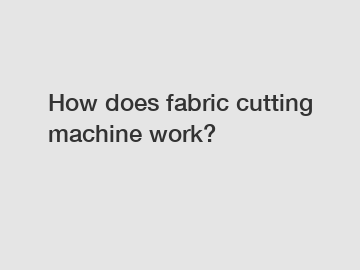How does fabric cutting machine work?
When it comes to creating stunning designs and precise measurements in the world of textiles, the technology-driven fabric cutting machine plays a crucial role. As a blend of precision engineering and advanced automation, these cutting-edge machines are transforming the fashion and textile industry, streamlining production processes, and enhancing efficiency. In this blog, we will delve into the intricacies of fabric cutting machines, discovering how they work and highlighting their numerous benefits.
1. The Evolution of Fabric Cutting Machines.
Fabric cutting machines have come a long way since their inception. Initially, manual shears were the primary tools utilized for cutting fabrics, necessitating time-consuming effort and resulting in irregular edges. Today, with the advent of technology, these machines have revolutionized the industry, offering speed, precision, and consistent results.

2. Automating Perfection: The Workflow.
Modern fabric cutting machines are designed to handle multiple layers of fabrics with exceptional precision. The process starts with a high-definition digital design, which is translated into a pattern through specialized software. This pattern is then transferred to the fabric cutting machine.
2.1. Layer Optimization.
The software facilitates layer optimization, allowing manufacturers to stack fabrics efficiently, minimizing material waste while maximizing productivity. By arranging various fabric layers accurately, the machine ensures informed cutting decisions while minimizing costly errors.
2.2. Preparing the Fabric.
Once the fabric layers are carefully arranged on the cutting table, they are fixed in place using vacuum suction. This firm grip allows the machine to achieve remarkable accuracy, ensuring perfect alignment throughout the cutting process.
3. The Power of Precision: Cutting Techniques.
Fabric cutting machines employ various techniques to precisely cut through multiple layers of fabric, depending on the materials and desired outcomes.
3.1. Straight Knife Cutting.
Straight knife cutting is one of the most common techniques employed by fabric cutting machines. Equipped with a sharp, straight blade, these machines seamlessly cut through layers of fabric using an up-and-down motion. This technique is ideal for non-slippery materials, ensuring clean, accurate cuts even at high speeds.
3.2. Rotary Blade Cutting.
For delicate or slippery fabrics, such as chiffons or silk, fabric cutting machines employ a rotary blade technique. The rotary blade ensures a smoother, continuous cutting motion, reducing the risk of fabric shifting during the process and delivering more precise cuts.
4. The Integration of Technology.
Fabric cutting machines leverage state-of-the-art technology to achieve unmatched precision and speed.
4.1. Computer Numerical Control (CNC) Systems.
CNC systems, combined with specialized software, enable fabric cutting machines to receive digital instructions and translate them into seamless, automated actions. These systems not only allow for complex designs and intricate patterns but also minimize human error, ensuring consistently accurate cuts.
4.2. Laser Cutting Technology.
The integration of laser cutting technology has introduced a new level of flexibility and precision in fabric cutting machines. Laser beams allow for intricate and sharp cuts, even on materials that may be challenging to handle. The advantages include cleaner edges, reduced fraying, and the ability to cut intricate shapes not achievable with traditional blade-cutting techniques.
5. Benefits of Fabric Cutting Machines.
The adoption of fabric cutting machines has transformed the textile industry, offering numerous benefits for manufacturers, designers, and end consumers alike.
5.1. Enhanced Efficiency.
Fabric cutting machines drastically reduce the time required to cut layers of fabric, greatly enhancing production efficiency. This accelerated pace allows manufacturers to meet tight deadlines without compromising quality, thereby boosting overall productivity.
5.2. Cost Reduction.
By streamlining the fabric-cutting process, these machines minimize labor costs and reduce material wastage. The optimization of fabric layers ensures maximum utilization, saving valuable resources and contributing to increased profitability.
5.3. Consistency and Accuracy.
Defying human limitations, fabric cutting machines ensure consistent results with incredible precision. Each cut is identical to the previous one, giving manufacturers the confidence to deliver impeccable products consistently.
Conclusion.
Fabric cutting machines have revolutionized the textile industry, enabling designers and manufacturers to achieve unmatched precision and productivity. By leveraging the power of automation, advanced cutting techniques, and integration of technology, these machines have set a new standard in the realm of fabric cutting. As an essential tool for modern-day fashion and textile production, these innovative machines continue to shape the industry, paving the way for new possibilities and creative endeavors.
DISCLAIMER: This article is the result of a collaborative effort between human experts and the AI language model GPT-3. While the AI component ensures a high degree of accuracy and offers valuable insights, it's important to acknowledge that the information provided should not be considered as a substitute for professional advice.
If you want to learn more, please visit our website Metal Straightening and Cutting Machine Factory, Welding Wire Straightening Device, Straightener Machine.
218
0
0

Comments
All Comments (0)